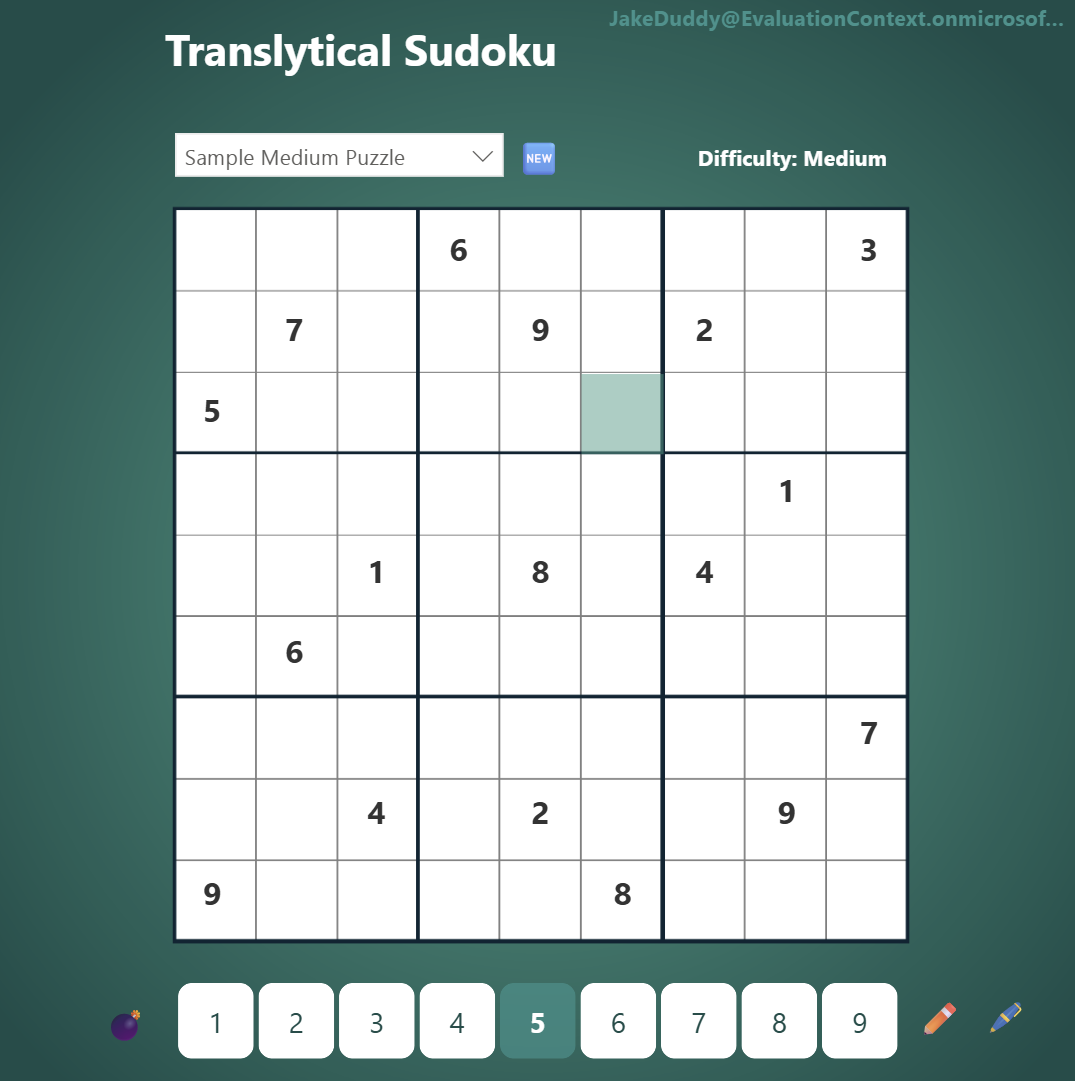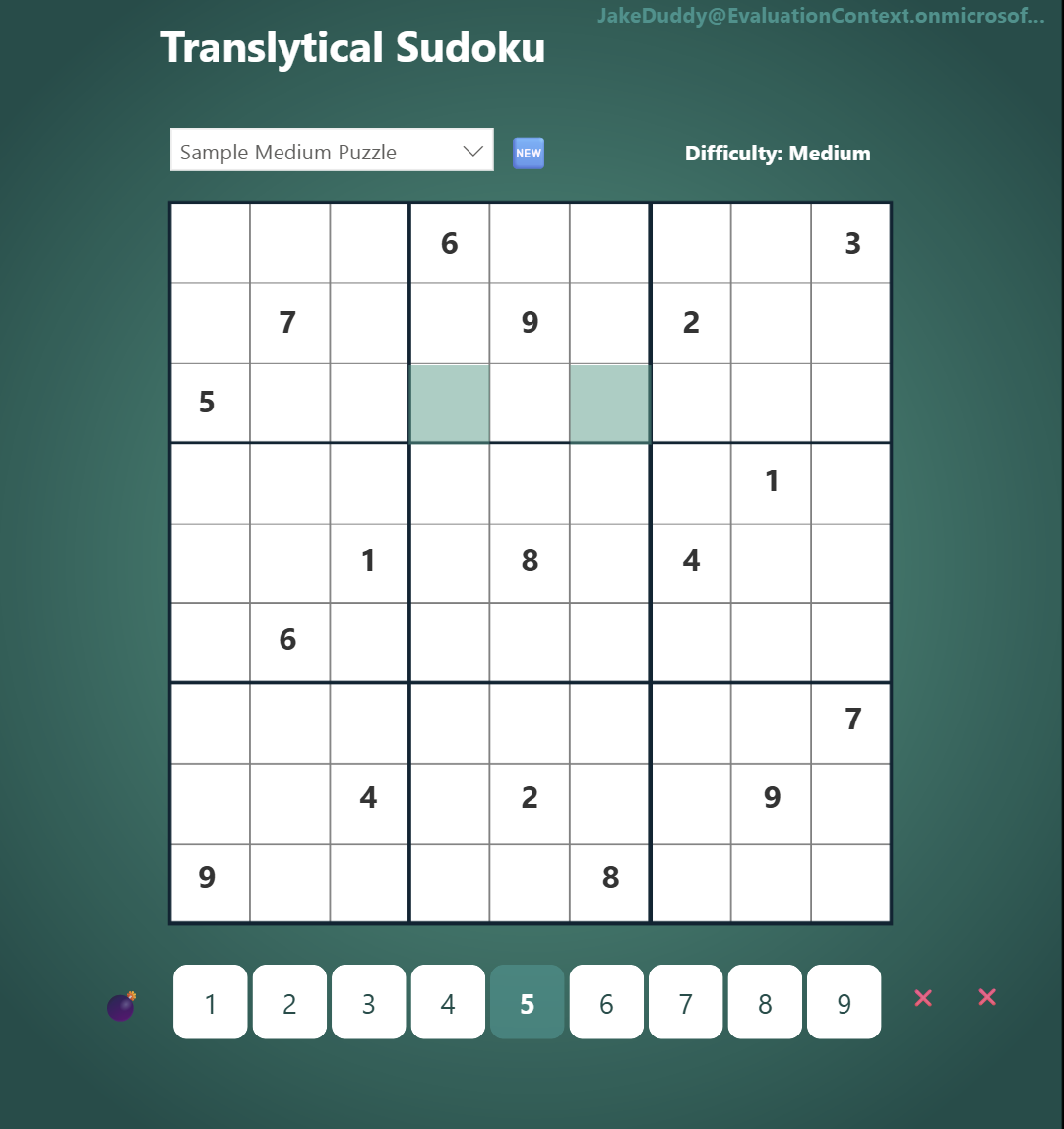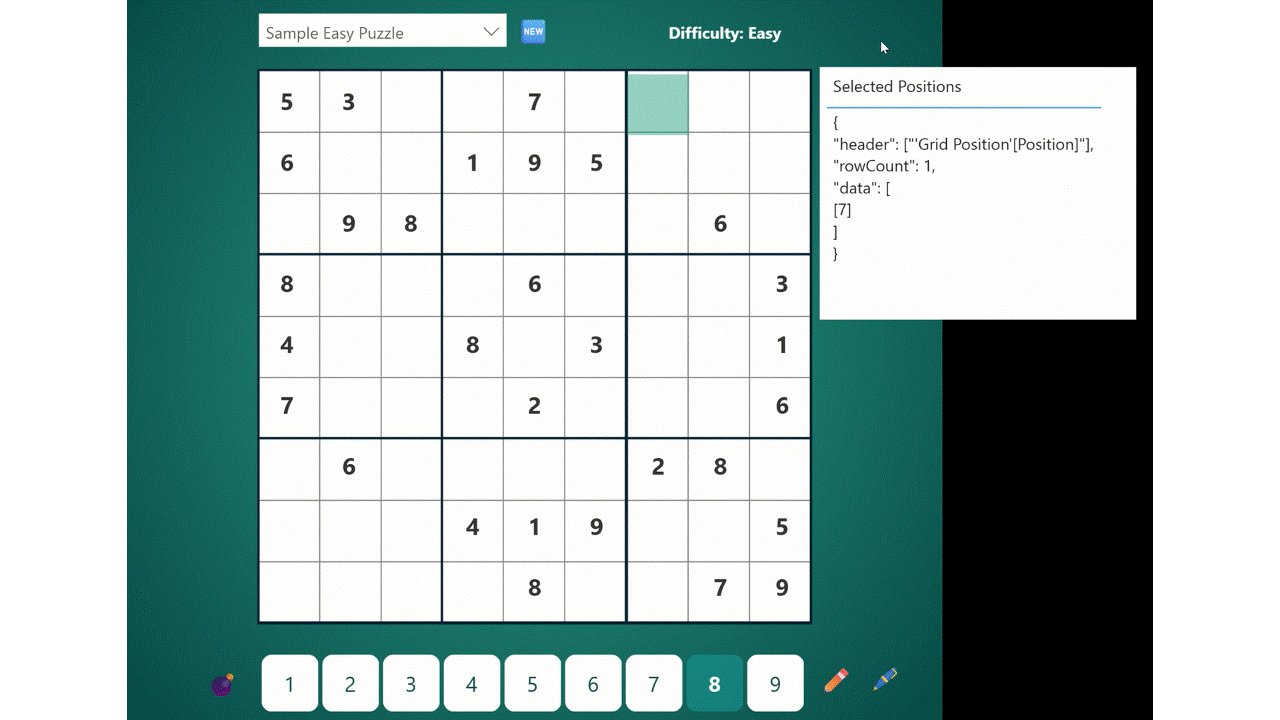Handling Multi-Row Inputs for Translytical Task Flows
Using DAX's TOJSON() function to pass multiple selected rows to UDFs when using Translytical Task Flows
In a previous post I explored using Translytical Task Flows to create Sudoku in Power BI. One potential improvement I mentioned was the ability for players to enter "pencil marks" into multiple cells simultaneously. This seemingly simple enhancement presents a technical challenge: how do we pass multiple row selections into a User-Defined Function (UDF) at the same time?
This post dives into the solution, demonstrating how to leverage the seldomly used DAX function, TOJSON(), to achieve this multi-row input capability.
Translytical Task Flows in Power BI¶
Before we delve into the solution, let's briefly revisit the basics of Translytical Task Flows in Power BI, as highlighted previously:
Translytical Sudoku
Translytical Task Flows, while still in preview, are a game-changer for Power BI users. To enable them, you'll need to go to Options > Preview features > Translytical Task Flows in Power BI Desktop.
At their core, they allow buttons within your Power BI reports to trigger Fabric User Data Functions (UDF). UDFs are python function that can perform an action such as initiate changes in a Fabric SQL database. Within the button definition you map a button, list, or text slicer; a data field; or measures from the report to the input parameters of the UDF.
The Challenge: Handling Multiple Selections¶
The existing toggle_pencil_mark() function, which handles player input, currently maps the GameId from a measure Selected GameId = SELECTEDVALUE( GameState[GameId] ), and the selected grid position and input value from two separate button slicers. This setup works perfectly for entering a single value into a single cell.
When a player selects just one cell in the Sudoku grid via a button slicer, all of our action buttons remain active, as expected:
However, the problem arises when a player attempts to select two or more cells simultaneously. The "pencil" button, designed for single-cell input, becomes inactive:
The cause of this limitation is that Power BI can only pass a single value to the UDF. To enable multi-cell input, we need a method to generate a single string that encapsulates information about multiple selected positions. For those familiar with REST APIs, calling the UDF in this context is analogous to a POST request, where the JSON format is the preferred payload.
The Solution: TOJSON()¶
Fortunately, DAX provides a perfect solution: the built-in TOJSON() function. This function is generates a JSON string from a given table.
A crucial consideration is to incorporate error handling for scenarios where the grid might not be filtered, potentially leading to all cells being selected. Let's create the DAX measure with this in mind:
Selected Positions =
IF(
ISFILTERED( 'Grid Position'[Position] ),
TOJSON( VALUES( 'Grid Position'[Position] ) )
)
This provides the following output:
With our DAX measure ready, the next step is to adapt our Python UDF to correctly parse and process this new JSON input.
Updating the UDF¶
Previously, our UDF expected an integer for the position variable. Now that we're sending a JSON string, we need to make the following adjustments:
- Variable Type Change: Modify the
positionvariable frominttostr - JSON String to Python Dictionary: Convert the JSON string to a python dictionary with
json.loads() - Iterate and Process: Loop through each position extracted from the JSON and call the stored procedure for each individual position to write the selected value
import fabric.functions as fn
import json
from datetime import datetime
udf = fn.UserDataFunctions()
@udf.connection(argName="sqlDB", alias="Game")
@udf.function()
def toggle_pencil_mark(sqlDB: fn.FabricSqlConnection, gameId: int, position: str, pencilValue: int) -> str:
"""
Toggle a pencil mark in a Sudoku cell
Args:
gameId: The game ID
position: JSON string with cell positions
pencilValue: Pencil mark value (1-9)
Returns:
JSON string with operation result
"""
try:
# Parse the JSON string to get positions
positions_data = json.loads(position)
positions = [pos[0] for pos in positions_data["data"]]
# Validate pencil value
if not (1 <= pencilValue <= 9):
return json.dumps({
"status": "ERROR",
"message": "Invalid pencil value. Value must be 1-9.",
"action_time": datetime.now().isoformat()
})
conn = sqlDB.connect()
cursor = conn.cursor()
processed_positions = []
filled_cells = []
last_action_type = None
last_is_active = False
for pos in positions:
# Validate position
if not (1 <= pos <= 81):
continue # Skip invalid positions
# Check if cell has a value (cannot add pencil marks)
cursor.execute("""
SELECT CurrentValue FROM GameState
WHERE GameId = ? AND Position = ?
""", (gameId, pos))
result = cursor.fetchone()
if result and result[0] is not None:
filled_cells.append(pos)
continue # Skip filled cells but continue with others
# Execute the stored procedure
cursor.execute("EXEC sp_TogglePencilMark ?, ?, ?",
(gameId, pos, pencilValue))
conn.commit()
# Check if pencil mark was added or removed
cursor.execute("""
SELECT IsActive FROM PencilMarks
WHERE GameId = ? AND Position = ? AND PencilValue = ?
""", (gameId, pos, pencilValue))
pencil_result = cursor.fetchone()
is_active = pencil_result[0] if pencil_result else False
last_action_type = "added" if is_active else "removed"
last_is_active = is_active
processed_positions.append(pos)
# Prepare response message
if not processed_positions and filled_cells:
return json.dumps({
"status": "ERROR",
"message": f"Cannot add pencil marks to filled cells at positions: {filled_cells}",
"action_time": datetime.now().isoformat()
})
elif not processed_positions:
return json.dumps({
"status": "ERROR",
"message": "No valid positions to process",
"action_time": datetime.now().isoformat()
})
# Build success message
message = f"Pencil mark {pencilValue} {last_action_type} at position(s) {processed_positions}"
if filled_cells:
message += f". Skipped filled cells at positions: {filled_cells}"
return json.dumps({
"status": "SUCCESS",
"message": message,
"game_id": gameId,
"positions_processed": processed_positions,
"positions_skipped": filled_cells,
"pencil_value": pencilValue,
"is_active": last_is_active,
"action_type": last_action_type,
"action_time": datetime.now().isoformat()
})
except json.JSONDecodeError:
return json.dumps({
"status": "ERROR",
"message": "Invalid JSON format for position parameter",
"action_time": datetime.now().isoformat()
})
except Exception as e:
return json.dumps({
"status": "ERROR",
"message": f"Database error: {str(e)}",
"action_time": datetime.now().isoformat()
})
finally:
if 'cursor' in locals():
cursor.close()
if 'conn' in locals():
conn.close()
Once these changes are published to your Fabric workspace, we can update the mapping in the Power BI report. Instead of mapping the single position, we now map our new Selected Positions measure to the UDF's position parameter.
And with that, we can now see it in action, allowing players to enter pencil marks into multiple cells simultaneously.
Conclusion¶
By combining DAX's TOJSON() function with a refined UDF, we can successfully pass multiple row selections using Translytical Task Flows. This capability significantly enhances the interactivity and user experience of our Sudoku game, allowing for more intuitive and efficient gameplay, and of course for more meaningful reporting solutions.





